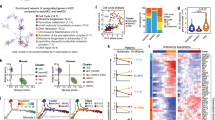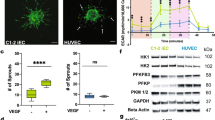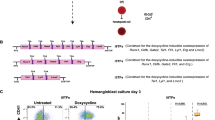Abstract
Previous efforts to differentiate human embryonic stem cells (hESCs) into endothelial cells have not achieved sustained expansion and stability of vascular cells. To define vasculogenic developmental pathways and enhance differentiation, we used an endothelial cell–specific VE-cadherin promoter driving green fluorescent protein (GFP) (hVPr-GFP) to screen for factors that promote vascular commitment. In phase 1 of our method, inhibition of transforming growth factor (TGF)β at day 7 of differentiation increases hVPr-GFP+ cells by tenfold. In phase 2, TGFβ inhibition maintains the proliferation and vascular identity of purified endothelial cells, resulting in a net 36-fold expansion of endothelial cells in homogenous monolayers, which exhibited a transcriptional profile of Id1highVEGFR2highVE-cadherin+ ephrinB2+. Using an Id1-YFP hESC reporter line, we showed that TGFβ inhibition sustains Id1 expression in hESC-derived endothelial cells and that Id1 is required for increased proliferation and preservation of endothelial cell commitment. Our approach provides a serum-free method for differentiation and long-term maintenance of hESC-derived endothelial cells at a scale relevant to clinical application.
This is a preview of subscription content, access via your institution
Access options
Subscribe to this journal
Receive 12 print issues and online access
$209.00 per year
only $17.42 per issue
Buy this article
- Purchase on Springer Link
- Instant access to full article PDF
Prices may be subject to local taxes which are calculated during checkout




Similar content being viewed by others
Accession codes
References
Thomson, J.A. et al. Embryonic stem cell lines derived from human blastocysts. Science 282, 1145–1147 (1998).
Yamahara, K. et al. Augmentation of neovascularization in hindlimb ischemia by combined transplantation of human embryonic stem cells-derived endothelial and mural cells. PLoS ONE 3, e1666 (2008).
Sone, M. et al. Pathway for differentiation of human embryonic stem cells to vascular cell components and their potential for vascular regeneration. Arterioscler. Thromb. Vasc. Biol. 27, 2127–2134 (2007).
Lu, S.J. et al. Generation of functional hemangioblasts from human embryonic stem cells. Nat. Methods 4, 501–509 (2007).
Goldman, O. et al. A boost of BMP4 accelerates the commitment of human embryonic stem cells to the endothelial lineage. Stem Cells 27, 1750–1759 (2009).
Nourse, M.B. et al. VEGF induces differentiation of functional endothelium from human embryonic stem cells: implications for tissue engineering. Arterioscler. Thromb. Vasc. Biol. 30, 80–89 (2009).
Bai, H. et al. BMP4 regulates vascular progenitor development in human embryonic stem cells through a smad-dependent pathway. J. Cell Biochem. published online, doi:10.1002/jcb.22410 (30 November 2009).
Huber, T.L., Kouskoff, V., Fehling, H.J., Palis, J. & Keller, G. Haemangioblast commitment is initiated in the primitive streak of the mouse embryo. Nature 432, 625–630 (2004).
Levenberg, S., Zoldan, J., Basevitch, Y. & Langer, R. Endothelial potential of human embryonic stem cells. Blood 110, 806–814 (2007).
Yang, L. et al. Human cardiovascular progenitor cells develop from a KDR+ embryonic-stem-cell-derived population. Nature 453, 524–528 (2008).
Inman, G.J. et al. SB-431542 is a potent and specific inhibitor of transforming growth factor-beta superfamily type I activin receptor-like kinase (ALK) receptors ALK4, ALK5, and ALK7. Mol. Pharmacol. 62, 65–74 (2002).
Gehling, U.M. et al. In vitro differentiation of endothelial cells from AC133-positive progenitor cells. Blood 95, 3106–3112 (2000).
Kelly, M.A. & Hirschi, K.K. Signaling hierarchy regulating human endothelial cell development. Arterioscler. Thromb. Vasc. Biol. 29, 718–724 (2009).
Peichev, M. et al. Expression of VEGFR-2 and AC133 by circulating human CD34(+) cells identifies a population of functional endothelial precursors. Blood 95, 952–958 (2000).
Rafii, S. & Lyden, D. Cancer. A few to flip the angiogenic switch. Science 319, 163–164 (2008).
Gao, D. et al. Endothelial progenitor cells control the angiogenic switch in mouse lung metastasis. Science 319, 195–198 (2008).
Lyden, D. et al. Impaired recruitment of bone-marrow-derived endothelial and hematopoietic precursor cells blocks tumor angiogenesis and growth. Nat. Med. 7, 1194–1201 (2001).
Rossig, L. et al. Histone deacetylase activity is essential for the expression of HoxA9 and for endothelial commitment of progenitor cells. J. Exp. Med. 201, 1825–1835 (2005).
Ruzinova, M.B. & Benezra, R. Id proteins in development, cell cycle and cancer. Trends Cell Biol. 13, 410–418 (2003).
Placantonakis, D.G. et al. BAC transgenesis in human embryonic stem cells as a novel tool to define the human neural lineage. Stem Cells 27, 521–532 (2009).
Watabe, T. et al. TGF-beta receptor kinase inhibitor enhances growth and integrity of embryonic stem cell-derived endothelial cells. J. Cell Biol. 163, 1303–1311 (2003).
Jankovic, V. et al. Id1 restrains myeloid commitment, maintaining the self-renewal capacity of hematopoietic stem cells. Proc. Natl. Acad. Sci. USA 104, 1260–1265 (2007).
Kang, Y., Chen, C.R. & Massague, J. A self-enabling TGFbeta response coupled to stress signaling: Smad engages stress response factor ATF3 for Id1 repression in epithelial cells. Mol. Cell 11, 915–926 (2003).
James, D., Noggle, S.A., Swigut, T. & Brivanlou, A.H. Contribution of human embryonic stem cells to mouse blastocysts. Dev. Biol. 295, 90–102 (2006).
Naldini, L. et al. In vivo gene delivery and stable transduction of nondividing cells by a lentiviral vector. Science 272, 263–267 (1996
Acknowledgements
We thank A. Brivanlou for providing the RUES1 hESC line. D.J., M.S. and G.L. are Fiona and Stanley Druckenmiller Fellows of the New York Stem Cell Foundation. S.R. is supported by Howard Hughes Medical Institute; Ansary Stem Cell Institute; Anbinder and Newmans Own Foundation; National Heart, Lung, and Blood Institute R01 grants HL075234 and HL097797; Qatar National Priorities Research Program; and Empire State Stem Cell Board and New York State Department of Health, NYS C024180.
Author information
Authors and Affiliations
Contributions
D.J. designed and performed the experiments and wrote the manuscript. H.-s.N. and R.B. designed and created the Id1-YFP BAC transgenic vector. M.S. performed experiments and contributed to the manuscript. D.N. performed flow cytometric experiments. T.J. performed molecular cloning. M.T. and L.S. generated the Id1-YFP BAC transgenic hESC line. L.S. and G.L. generated the FD iPSC line. N.Z. and Z.R. generated the hESC lines WMC2, WMC8 and WMC9. D.L. and S.Y.R. designed experiments and performed data analysis. S.R. designed experiments and wrote the manuscript.
Corresponding author
Ethics declarations
Competing interests
The authors declare no competing financial interests.
Supplementary information
Supplementary Text and Figures
Supplementary Figs.1–5 and Supplementary Tables 1 (PDF 9976 kb)
Supplementary Video 1
Detection of vasculogenesis in Real-Time: hVPr-GFP+ cells appear at day 5 and connect to form primitive vascular tubules. (MOV 21888 kb)
Supplementary Video 2
Real-Time Tracking of hESC-derived ECs: Remodeling of hVPr-GFP+ vessel-like structures in adhering EBs (MOV 7553 kb)
Supplementary Video 3
Establishment of vascular patterning: Human VPr-GFP+ cells form branching microvascular structures with closed lumens. (MOV 7488 kb)
Supplementary Video 4
Tubulogenesis of human neo-vessels in vitro: Human VPr-GFP+ cells reorganize into large vessel-like structures following extendeddifferentiation in vitro. (MOV 3244 kb)
Supplementary Video 5
Whole-well immunodetection of non-endothelial cell types that emerge from hESC-derived ECs in the absence of TGF inhibition. (MOV 9813 kb)
Supplementary Video 6
Whole-well immunodetection of mitotic hESC-derived ECs in the absence of TGF inhibition. (MOV 58218 kb)
Supplementary Video 7
Whole-well immunodetection of mitotic hESC-derived ECs in the presence of TGF inhibition. (MOV 67678 kb)
Supplementary Video 8
Human ESC-derived ECs cultured in the presence of TGF inhibitor form functional vessels in vivo. (MOV 8313 kb)
Supplementary Video 9
Human ESC-derived ECs cultured in the presence of TGF inhibitor form functional vessels in vivo. (MOV 14639 kb)
Rights and permissions
About this article
Cite this article
James, D., Nam, Hs., Seandel, M. et al. Expansion and maintenance of human embryonic stem cell–derived endothelial cells by TGFβ inhibition is Id1 dependent. Nat Biotechnol 28, 161–166 (2010). https://doi.org/10.1038/nbt.1605
Received:
Accepted:
Published:
Issue Date:
DOI: https://doi.org/10.1038/nbt.1605
This article is cited by
-
Advancing cardiac regeneration through 3D bioprinting: methods, applications, and future directions
Heart Failure Reviews (2023)
-
Human CD34+ very small embryonic-like stem cells can give rise to endothelial colony-forming cells with a multistep differentiation strategy using UM171 and nicotinamide acid
Leukemia (2022)
-
Engineering bioactive nanoparticles to rejuvenate vascular progenitor cells
Communications Biology (2022)
-
Stepwise differentiation and functional characterization of human induced pluripotent stem cell-derived choroidal endothelial cells
Stem Cell Research & Therapy (2020)
-
Clonally selected primitive endothelial cells promote occlusive pulmonary arteriopathy and severe pulmonary hypertension in rats exposed to chronic hypoxia
Scientific Reports (2020)



